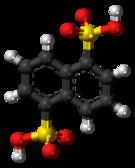Formula C10H8S2O6 Classification Sulfonic acid | Molar mass 288.299 g/mol Appearance colorless solid | |
 | ||
Armstrong's acid (naphthalene-1,5-disulfonic acid) is an organic compound with the formula C10H6(SO3H)2. It is one of several isomers of naphthalenedisulfonic acid. It a colorless solid, typically obtained as the tetrahydrate. Like other sulfonic acids, it is a strong acid. It is named for British chemist Henry Edward Armstrong.
Contents
Production and use
It is prepared by disulfonation of naphthalene with oleum:
C10H8 + 2 SO3 → C10H6(SO3H)2Further sulfonation gives The 1,3,5-trisulfonic acid derivative.
Reactions and uses
Fusion of Armstrong's acid in NaOH gives the disodium salt of 1,5-dihydroxynaphthalene, which can be acidified to give the diol. The intermediate in this hydrolysis, 1-hydroxynaphthalene-5-sulfonic acid, is also useful. Nitration gives nitrodisulfonic acids, which are precursors to amino derivatives.
The disodium salt is sometimes used as a divalent counterion for forming salts of basic drug compounds, as an alternative to the related mesylate or tosylate salts. When used in this way such a salt is called a naphthalenedisulfonate salt, as seen with the most common salt form of the stimulant drug CFT. The disodium salt is also used as an electrolyte in certain kinds of chromatography.
